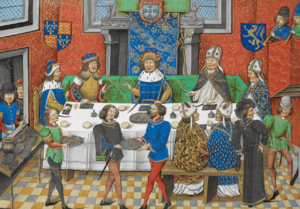John I of Portugal facts for kids
Quick facts for kids John I |
|
|---|---|

Portrait painted c. 1435
|
|
| King of Portugal (more...) | |
| Reign | 6 April 1385 – 14 August 1433 |
| Acclamation | 6 April 1385 |
| Predecessor | Beatrice (disputed) or Ferdinand I |
| Successor | Edward |
| Born | 11 April 1357 Lisbon, Portugal |
| Died | 14 August 1433 (aged 76) Lisbon, Portugal |
| Burial | Batalha Monastery |
| Spouse | Philippa of Lancaster (m. 1387, d. 1415) |
| Issue among others... |
|
| House | Aviz |
| Father | Peter I of Portugal |
| Mother | Teresa Lourenço |
| Signature |  |
John I (Portuguese: João; 11 April 1357 – 14 August 1433) was the King of Portugal for a very long time, from 1385 until he died in 1433. He is often called John of Aviz.
He is famous for helping Portugal win a big war against Castile. This war kept Portugal independent and started a new royal family, the Aviz dynasty. His reign lasted 48 years, which is the longest of any Portuguese king! During his time, Portugal also began exploring and expanding overseas. People remember him as "of Fond Memory" (de Boa Memória) or "the Good" (o Bom).
Contents
Early Life of John I
John was born in Lisbon. He was the son of King Peter I of Portugal and a woman named Teresa Lourenço. In 1364, he became the Grand Master of the Order of Aviz. This was a special religious and military group.
In October 1383, his half-brother, King Ferdinand I of Portugal, died without a son. Ferdinand's only daughter, Beatrice of Portugal, was supposed to become queen. She was married to King John I of Castile. Many people in Portugal worried that if Beatrice became queen, Portugal would become part of Castile.
This led to a time of big trouble and no clear ruler, called the 1383–1385 Portuguese interregnum.
Becoming King of Portugal

On April 6, 1385, important leaders in Portugal met in Coimbra. They decided that John, the Master of Aviz, should be the new King of Portugal. This started a war against Castile, who still claimed the Portuguese throne.
King John I of Castile then invaded Portugal with his army, trying to take Lisbon. He had help from French soldiers. But King John I of Portugal had help from English troops.
John and his brave general, Nuno Álvares Pereira, fought back. They won a very important battle called the Battle of Aljubarrota on August 14, 1385. This victory made Portugal's independence safe forever.
On February 14, 1387, King John I married Philippa of Lancaster. She was the daughter of John of Gaunt, an important English leader. This marriage created a strong friendship between England and Portugal, which is still important today.
King John's Reign

In 1390, King John I of Castile died. He had no children with Beatrice, which ended Castile's claim to the Portuguese throne. This meant King John I of Portugal could rule in peace. He focused on making Portugal stronger and exploring new lands.
One big event was the capture of the city of Ceuta in North Africa in 1415. Portugal also successfully defended Ceuta from attack in 1419. These actions helped Portugal control important sea routes and trade from Africa.
King John also asked the Pope to recognize these battles as a Crusade. This would allow people captured in battle to be sold as slaves. The Pope agreed in 1418, giving John rights to lands he won from the Moors.
Under the leadership of his son, Prince Henry the Navigator, Portugal began exploring the African coast. This led to the discovery of the islands of Madeira in 1417 and the Azores in 1427. Portugal claimed both of these islands.
Writers from that time said John was smart and wanted to keep power. But they also said he was kind and good-natured. He was very educated for a king in the Middle Ages. He loved learning and passed this on to his children.
His children are often called the "illustrious generation" because they were so talented:
- Edward became the next king and was a poet and writer.
- Peter was one of the most learned princes of his time.
- Prince Henry the Navigator focused on science and sea exploration.
- His only daughter, Isabella, married a powerful duke and had a very cultured court.
Family and Children
On February 2, 1387, King John I married Philippa of Lancaster in Porto. They had several famous children, known as the "illustrious generation."
| Name | Birth | Death | Notes |
|---|---|---|---|
| Children with Philippa of Lancaster (married on February 2, 1387) | |||
| Infanta Blanche | July 13, 1388 | March 6, 1389 | Died young. |
| Infante Afonso | July 30, 1390 | December 22, 1400 | Died young. |
| King Edward | October 31, 1391 | September 13, 1438 | Became the next King of Portugal. |
| Infante Peter | December 9, 1392 | May 20, 1449 | Duke of Coimbra. |
| Infante Henry | March 4, 1394 | November 13, 1460 | Known as Henry the Navigator. |
| Infanta Isabella | February 21, 1397 | December 11, 1471 | Duchess of Burgundy. |
| Infante John | January 13, 1400 | October 18, 1442 | A high-ranking officer in the kingdom. |
| Infante Ferdinand | September 29, 1402 | June 5, 1443 | Died while held captive in Fes, Morocco. |
See also
 In Spanish: Juan I de Portugal para niños
In Spanish: Juan I de Portugal para niños

